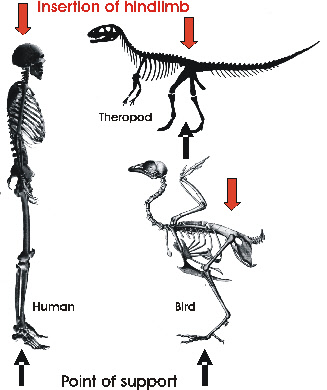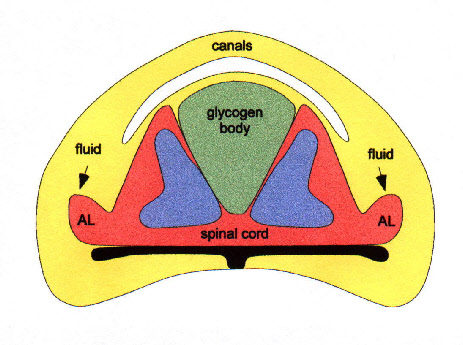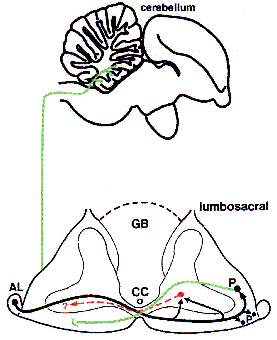


Lumbosacral organ
Because of a nearly horizontal orientation of the body and an insertion of the hindlimbs caudal to the center of gravity of the body, birds' bipedal walking on the ground needs special control of balance. The bipedal theropod dinosaurs had a long tail for balance which lacks in birds. In the upright walking bipedal humans the center of gravity is in line with the legs.
Birds have specializations in the pelvic region near the insertion of the hindlimbs. These specializations include a widening of the vertebral canal with large fluid spaces, a splitted spinal cord which houses a glycogen body and outlying nerve cells which form accessory lobes and which lie below the opening of transverse canals (see Model). Recent anatomical, histological, ultrastructural, electrophysiological and behavioral evidences support the function of these specializations as a sense organ of equilibrium which controls walking on the ground. Movements of the body (e.g. tilting) result in relative movements of the fluid in the canals because of inertia. These fluid movements result in a distortion of the accessory lobes which contain mechanosensitive neurons. The activity of these neurons is tranmitted to the local motor network and to the cerebellum (see Neuronal network).
Model of the lumbosacral system: cerebrospinal fluid moves during tilting of the body and distorts the accessory lobes (AL) which contain sensory neurons
Neuronal network of accessory lobe neurons: they project to contralateral spinal
cord where they contact local interneurons, which act on the motor system, and paragriseal
cells (P) which project to the anterior cerebellum
Literature:
Necker, R.: Specializations in the lumbosacral spinal cord of birds: morphological
and behavioural evidence for a sense of equilibrium. Eur J Morphol 37, 211-214 (1999)
Necker
R, Janßen A and Beissenhirtz T: Behavioral evidence of the role of lumbosacral anatomical
specializations in pigeons in maintaining equilibrium during terrestrial locomotion.
J Comp Physiol A, 186, 409-412 (2000)
Necker R: The structure and development of avian lumbosacral specializations of the
vertebral canal and te spinal cord with special reference to a possible function
as a sense organ of equilibrium. Anat Embryol 210: 59-74 (2005)
Necker R: Specializations
in the lumbosacral vertebral canal and spinal cord of birds: evidence of a function
as a sense organ which is involved in the control of walking. J Comp Physiol A 192:439-448
(2006). (see download link of PDF file at the top)
Recent Publications:
Stanchak KE, French C, Perkel DJ, Brunton BW: The balance hypthesis for the avian lumbosacral organ and an exploration of its morphological variation. Integrative Organismal Biology, Volume 2, issue 1, 2020, obaa024 https:/doi.org/10.1093/iob/obaa024
Kamska V, Daley M and Badri-Spröwitz A: 3D anatomy of the quail lumbosacral spinal
canal - implications for putative mechanosensory function. Integr. Org. Biol. 2020
2(1) abaa037
Sense organ of equilibrium in the spinal cord controls walking
See Review Necker 2006. Download:










